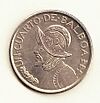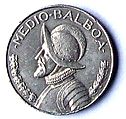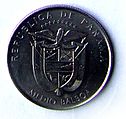Panamanian balboa facts for kids
Quick facts for kids Panamanian balboa |
|||||
|---|---|---|---|---|---|
|
|||||
| ISO 4217 Code | PAB | ||||
| User(s) | |||||
| Pegged with | U.S. dollar at par | ||||
| Subunit | |||||
| 1⁄100 | Centésimo | ||||
| Symbol | B/. or ฿. | ||||
| Coins | 1 and 5 centésimos, 1⁄10, 1⁄4, 1⁄2, and 1 balboa | ||||
| Banknotes | None (U.S. banknotes are employed instead, although denominated in balboas) | ||||
| 1 Panama now uses U.S. dollar notes. | |||||
The balboa (sign: B/.; ISO 4217: PAB) is the official money of Panama, used together with the United States dollar. It is named after Vasco Núñez de Balboa, a famous Spanish explorer. The balboa is divided into 100 smaller parts called centésimos.
History
The balboa became Panama's money in 1904. This happened right after Panama gained its independence. Since then, the balboa has always been linked to the United States dollar at a 1:1 value. This means one balboa is always worth one U.S. dollar. Both currencies are used side-by-side in Panama.
Panama has never had its own official central bank. A central bank usually handles a country's money supply. Instead, the National Bank of Panama, which is a government-owned bank, helps manage some of these tasks. Another group, the National Banking Commission, helps supervise banks in Panama.
Coins
Current Coins
Panama uses several coins for the balboa. These coins are very similar in size and what they are made of to U.S. coins.
| Denomination | Obverse | Reverse | Diameter | Thickness | Mass | Composition | Edge | Minted | |
|---|---|---|---|---|---|---|---|---|---|
| Un centésimo (B/. 0.01) |  |
Urracá | Denomination | 19.05 mm | 1.55 mm | 3.11 g | Copper 95% Tin/Zinc 5% |
Smooth | 1935–1982 |
| 2.50 g | Copper 2.5% Zinc 97.5% |
1983–Present | |||||||
| Cinco centésimos de balboa (B/. 0.05) |  |
Denomination | Panamanian Coat of Arms | 21.21 mm | 1.95 mm | 5 g | Copper 25% Nickel 75% |
Smooth | 1929–Present |
| Un décimo de balboa (B/. 0.10) |  |
Vasco Núñez de Balboa | 17.91 mm | 1.35 mm | 2.268g | Copper 91.67% Nickel 8.33% |
118 reeds | 1966–Present | |
| Un cuarto de balboa (B/. 0.25) |  |
24.26 mm | 1.75 mm | 5.67g | 119 reeds | ||||
| Medio balboa (B/. 0.50) |  |
30.61 mm | 2.15 mm | 11.34 g | 150 reeds | 1973–Present | |||
| Un balboa (B/. 1) |  |
Liberty with Panamanian Coat of Arms | 38.1 mm | 2.58 mm | 22.68 g | reeded | 1973–2010 | ||
| Panamanian Coat of Arms | 26.5 mm | 2 mm | 7.2 g | Outer ring: Nickel-plated steel Center: Nickel-brass-plated steel |
reeded with inscription | 2011–Present | |||
Older Coins
In 1904, Panama first made silver coins in values like 2½, 5, 10, 25, and 50 centésimos. The 2½ centésimos coin was very small, weighing only 1.25 grams. Because of its tiny size, people called it the "Panama pill" or the "Panama pearl."
Later, in 1907, coins made of copper-nickel were introduced. These included the ½ and 2½ centésimo coins. In 1929, 5 centésimo coins also started being made from copper-nickel.
In the 1930s, coins for 1/10, 1/4, and 1/2 balboa were made. A 1 balboa coin followed in 1931. These coins were exactly like the matching U.S. coins in size and what they were made of. In 1935, bronze 1 centésimo coins were introduced, and in 1940, 1¼ centésimo coins were minted.
In 1966, Panama changed the materials for its silver coins, just like the U.S. did. For example, the 1/10 and 1/4 balboa coins were made with copper-nickel. The 1/2 balboa coin used less silver. A 1 balboa silver coin was also made that year, the first since 1947.
By 1973, the 1/2 balboa coins were made of copper-nickel. The 2½ centésimos coin was brought back in 1973, but it was stopped two years later because people didn't use it much. In 1983, 1 centésimo coins changed from copper to copper-plated zinc, just like the U.S. cent. Larger 1 balboa coins have been made since 1982, still made of copper-nickel.
Today, the 1 and 5 centésimo, 1/10, 1/4, and 1/2 balboa coins are the same weight, size, and material as the U.S. cent, nickel, dime, quarter, and half dollar. In 2011, new 1-balboa coins were made from two different metals. They are the same size as the U.S. dollar coin.
Panama has also made special commemorative coins to celebrate events or people. These coins have values like 5, 10, 20, 50, 75, 100, 150, 200, and 500 balboas. In 1971, a 20 balboa silver coin was made to honor Simón Bolívar. It was the largest silver coin in the world at that time!
| Denomination | Obverse | Reverse | Diameter | Thickness | Mass | Composition | Edge | Minted |
|---|---|---|---|---|---|---|---|---|
| Medio Centesimo de Balboa (1⁄2¢) (No longer used since 1940) |
Vasco Núñez de Balboa | Denomination | Copper-nickel | Smooth | 1907 | |||
| Uno y Cuarto Centesimos (1+1⁄4¢) (No longer used since 1970) |
Vasco Núñez de Balboa | Denomination | Copper 95% Tin/Zinc 5% |
Smooth | 1940 | |||
| Dos y Medio Centesimos de Balboa (2+1⁄2¢) (No longer used since 1976) |
Vasco Núñez de Balboa | Panamanian Coat of Arms | 1.25 g | 90% Silver, 10% copper | Smooth | 1904 | ||
| Denomination | 18 mm | 3.3 g | Copper-nickel | 1907–1940 | ||||
| Panamanian Coat of Arms | 10 mm | Copper-nickel-plated copper | 1973–1976 |
Banknotes
Panama does not print its own paper money. Instead, it uses U.S. banknotes for all its cash needs.
In 1941, Panama's President Arnulfo Arias tried to start a central bank to print paper money. The bank was created on September 30, 1941. However, President Arias was removed from power in October. The new banknotes were then taken out of circulation and most were destroyed.
Exchange Rate
| Current PAB exchange rates | |
|---|---|
| From Google Finance: | AUD CAD CHF EUR GBP HKD JPY USD EUR JPY USD |
| From Yahoo! Finance: | AUD CAD CHF EUR GBP HKD JPY USD EUR JPY USD |
| From XE.com: | AUD CAD CHF EUR GBP HKD JPY USD EUR JPY USD |
| From OANDA: | AUD CAD CHF EUR GBP HKD JPY USD EUR JPY USD |
| From fxtop.com: | AUD CAD CHF EUR GBP HKD JPY USD EUR JPY USD |
See also
 In Spanish: Balboa (moneda de Panamá) para niños
In Spanish: Balboa (moneda de Panamá) para niños
- Economy of Panama



